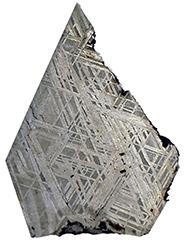

This small, acid-etched, thin-sawed slice from an iron meteorite was found near Licking, Missouri. Department geologist, Patrick Mulvany, Ph.D., was the first to identify it as an octahedrite iron meteorite. It was found and originally brought to the office for identification in 2015 by Don and James Goes. It was the first meteorite authenticated by department staff in more than 80 years. Read more about their find.
A space rock smaller than approximately one yard across will likely burn up completely during passage through Earth’s atmosphere. This is what we see as meteors (shooting stars) and fireballs. Larger space rocks up to approximately 10 yards across have a good chance of landing intact or in pieces on the Earth as meteorites.
About 40,000 meteorites have been found on Earth. As many as 1,000 meteorites land on the planet every year. They are extremely difficult to find. Most will never be discovered, having landed in the oceans or in vegetated terrains. A space rock larger than 10 yards across will slow very little as it shoots through the atmosphere in a blazing sun-bright fireball. It then impacts the Earth’s surface creating a tremendous explosion that totally vaporizes the space rock and forms a crater. The smaller space rocks produce simple bowl-shaped craters, such as the one-mile diameter crater in Arizona known as Meteor Crater. Bigger space rocks produce larger and more complex craters. These craters can be more than 10 miles in diameter and are characterized by a circular, central uplifted area that is surrounded by a ring-shaped downdropped area. The Chicxulub circular geologic feature in the Gulf of Mexico, just north of the Yucatan, is an example of a huge complex crater.
The geographic area that is now Missouri was hit at least twice and probably three times by crater-forming space rocks. The two confirmed meteorite impacts are the Crooked Creek structure (Crawford County) and the Decaturville structure (Camden County), both of which are several miles in diameter. The presence of shatter cones and shocked quartz in the rocks of these two structures is proof they were caused by meteorite impact. Shatter cones are conical fractures in the bedrock beneath meteorite impact craters or underground nuclear explosions. Shocked quartz grains are produced by the force of an impact on sandstone rocks. The crystal structure is different than standard quartz and is visible when greatly magnified.
Geologic maps of these structures reveal the characteristic central uplift portion that is encircled by a ring graben – a down-dropped block of the earth’s crust. The Weaubleau structure in Hickory County is likely an impact feature, as well. The Crooked Creek and Decaturville impact structures are in line with at least six other localized structural disturbances that occur from southern Illinois and Missouri and extend just into eastern Kansas.
From east to west, the disturbances are Hicks Dome, Avon, Furnace Creek, Crooked Creek, Hazelgreen, Decaturville, Weaubleau and Rose Dome. This line of structures defines what has been called the “38th parallel lineament” because it closely approximates the 38th parallel line of geographic latitude.
Note: Searching for meteorites and exploring impact craters are like other outdoor adventures in that it is important to respect private and public property rights.
The small, acid-etched, thin-sawed slice from the meteorite found by Don and James Goes is on display in our Ed Clark Museum of Missouri Geology.
